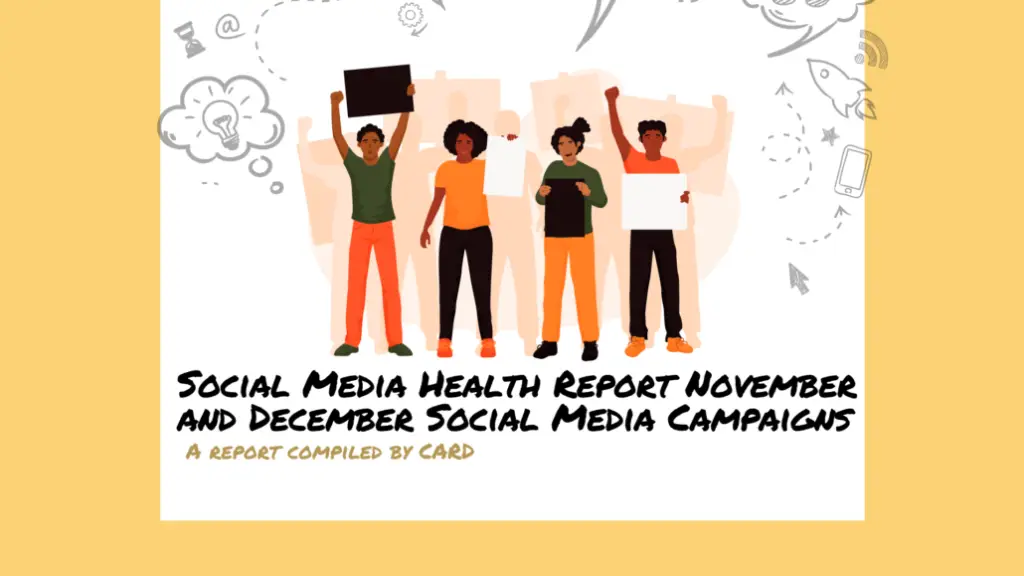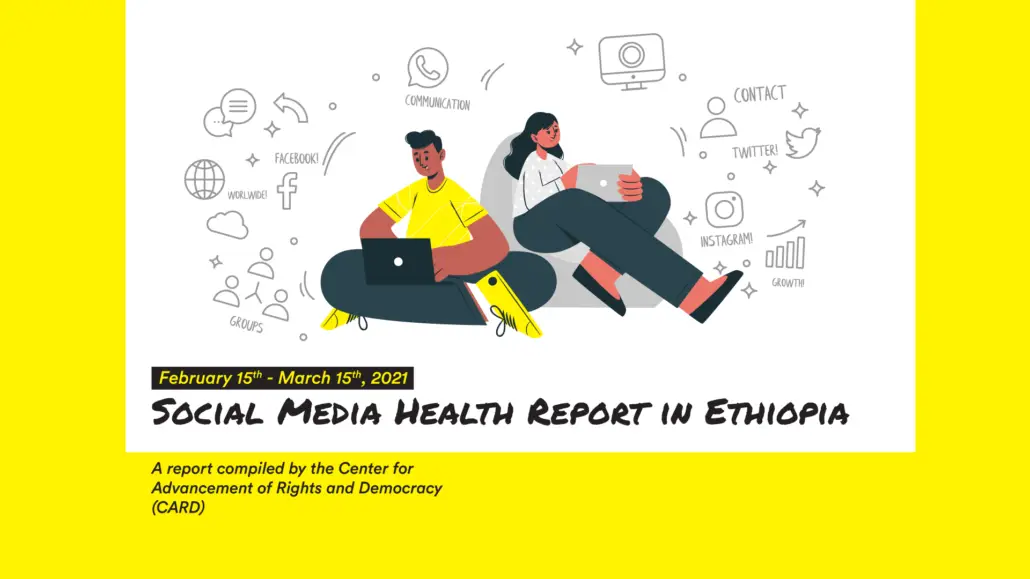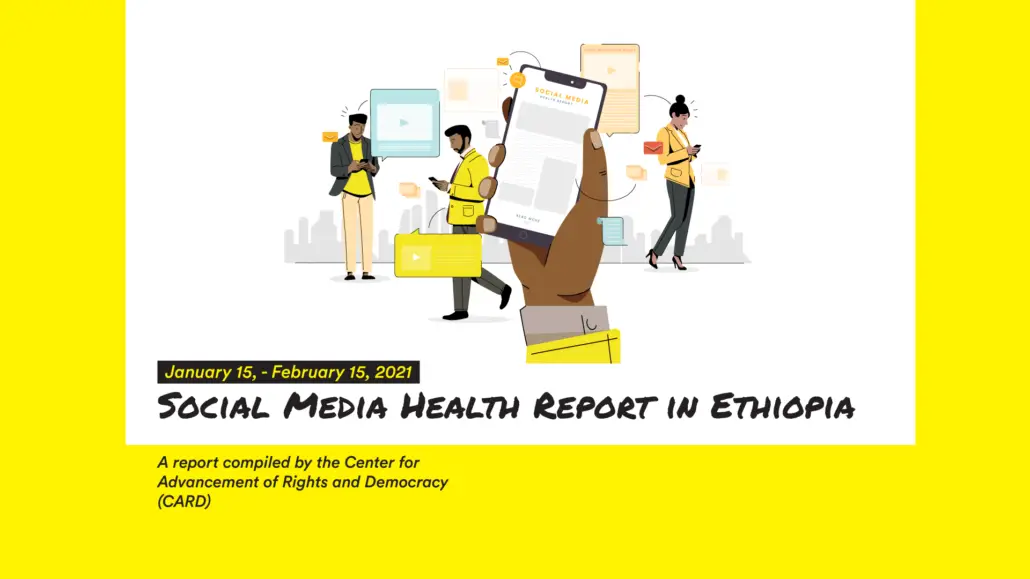A report compiled by CARD
Introduction
This social media health report construes the monitoring conducted in the working days between the 15th of November through the 15th of December 2020. The monitoring of this month includes the overall assessment of social media activities through the platform of Crowd tangle and Brandwatch.
- A twitter campaign with the hashtag #NationalDialogueNow (November 20th)
A 24-hour twitter campaign was held demanding for an all-inclusive national dialogue to end the crisis in Ethiopia. According to the organizers of the campaign, the idea of the campaign was peace and negotiation to solve the problem the country is in.

Image 1: Call for the campaign using the hashtag #NationalDialogueNow

Graph 1: Mentions volume trend of the campaign.
The above chart depicts the total tweets made using the hashtag #NationalDialogueNow from the 16th –24th of November. We can see that it reached its peak on the 20th of November, which is the date picked for the campaign by the organizers. A total of 65,000 mentions were made using the hashtag by 5757 unique authors. It had been trending in Ethiopia as can be seen below.

Image 2: Twitter trend on the 20th of November
- The 16 days of activism (November 25th– December 10th)
The annual worldwide international campaign that calls for the prevention and the elimination of violence against Women took place with this year’s global theme: “Orange the World: Fund, Respond, Prevent, Collect!” The campaign took place from the international day of elimination of violence against women(VAW) on the 25th of November until the 10th of December (International Human Rights Day). Social media users joined the campaign by changing their profile to orange and producing and sharing content with the hashtag #OrangeTheWorld, #16Days and #GenerationEquality.

Image 3: A poster of the campaign having the theme of the year.
- Campaigns with the hashtag #WaronTigray, #Tigraywillprevail, #IstandwithTigray, #ReconnectTigray
There was Tigryan activist’s social media campaign with the hashtags #Tigraywillprevail #WarOnTigray, #IStandWithTigray and #TigrayGenocide. This was following the tension between the Federal and Tigray government. A total of 118,000 mentions were made using the hashtag by 9822 unique authors.

Graph 2: Mention volume trend of the campaign.
Graph 3 below shows that many hashtags were used during the campaign with the leading hashtag and sub hashtags mentioned in the chart. Hashtags like #stopwarontigray, #ExpirencingEthnicProfiling, #RevokeNobelPrize, #WithdrawEritreanTroopsFromTigray also trended. The issues raised ranged from calling an end to genocide on Tigray to showing gratitude to Sudan for receiving refugees fleeing from the conflict zone. #StopWarOnTigray hashtag use has been seen to fade away in the past weeks. Unique to this campaign is that most of the tweets have been tweeted from the USA (11,122) rather than from Ethiopia (6,788).

Graph 3: Hashtags used during the campaign.
- A Twitter campaign with the hashtag #CrisisinEthiopia
This Twitter campaign, according to the organizers, was aimed at showing that a crisis was happening in Oromia, people were dying in many places and those who are feared to lead the Oromo struggle were being thrown into prison without any crime.

Image 4: Call for the campaign using the hashtag #Oromoprotest, CrisisinEthiopia

Graph 4: Mention volume of #EthiopiaCrises. It had reached its maximum peak on Twitter on the 6th of December. The total mention of these tweets was 17,000 by 2,397 unique authors.
- Celebration of the Nation and nationalities day on social media (December 6th-8th)
This year’s annual Nation and Nationalities Day was also celebrated on social media. People who are in favor of Ethiopia’s federation and call it “multinational federal system” organized this social media campaign and the messages were shared by users who support the idea. For three consecutive days from the 6th of December to the 8th of December, the Federal Government’s logo was used as a profile image in a campaign celebrating the federation.
On December 6 and 7, previous speeches about the benefits of the Constitution and the federal system were shared. On the date of the annual celebration, various articles on the importance of the federal system and the constitution which is the basis of the system were shared.
There were discussions and debates between who supported and criticized the federalism system.

Image 5: Poster promoting the celebration of Nation and Nationalities Day on social media.
Posts by Prominent Activists
The two screenshots below (see Image 6) were posted by a well-known diaspora Tigriyan activist (who has 192,972 followers on Facebook) and another Oromo activist respectively. As we can see, the first post alone has 1.1k reactions and 113 shares and the second post has 1.1k reactions and 350 shares by the time this screenshot was taken. Both posts contain a negative message towards the people of Amhara. The second post used a derogatory term ‘Neftegna’ instead of directly referring to Amhara people. Such contents need further investigation and monitoring as they might open the door for offensive measures by other ethnic groups against the Amhara.
Translation: This retruning Ethiopia Amhara again (Make Ethiopia Amhara Again) genocide war is not ordinary matter, soon it’s going to consume everyone, as it is about whose turn it is. Therefore, in your surroundings outside your home before it is said “he murdered as much as he can and restored the land” get yourself respected, fight.


Image 6: Posts that may result in offense against Amharas.
A well interacted post post (see Image 7) by a well-known Oromo activist, claimed Amhara officials are disseminating as though Gumuz ethnics are engaged in cannibalism.
Translation of the post: “what else is hate speech more than this??? “Shanqillas are barbaric who kill and eat the flesh of humans and who then use the bones to beat drum and dance” Imagine that these are the people who preach us about tolerance and unity. What kind of addiction is this to paint people such kind of dirt for their land??? As you can see below, this campaign was opened against Gumuz people and had caused genocide of 400 Gumuze ethnics. Amhara officials are even appearing on TV to disseminate an agenda claiming that Gumuz are eating humans.” And, he attached a post that accuses Gumuz people of cannibalism. The page he shared is anonymous page that has no clear affiliation to Amhara officials.

Image 7: A post claiming that Amhara officials are engaged in disseminating information that claims Gumuz people are doing cannibalism.
In a related note, a Facebook user who claimed to have witnessed dead bodies and testimony of a Gumuz member to have killed and eaten “light skinned” people for traditional custom. The person claimed to be an education expert in the region at Metekel zone. His post, titled “testimony”, had been reproduced multiple times by other Facebook users and pages and had triggered conversation. In an attempt to confirm if there were peer-reviewed researches that affirm the claim of cannibalism tradition in this community, we found nothing. However, Amhara regional official also made similar claims on state-run television (see below).

Image 8: A claim that the spiritual ark of St. George in Addis Ababa was stolen from Axum Zion church in Tigray.
Another post (with 663 reactions and 98 shares, see Image 8) claimed that a religious ark that is found in Addis Ababa, capital of Ethiopia had been stolen and brought by the late Emperor Menelik II after the victory of Adwa and further claimed that there is an attempt to take the “ark of covenant”, a sacred ark made by Moses and said to exist at the Axum Zion Church, from Tigray to Amhara region in the name of security.
Speeches by Government Officials
A total of 40:46 minutes of an interview was aired on Amhara mass media agency. The interviewee, the commissioner of the Amhara Regional Police Commission, Abere Adamu stated the following at 35:00-40:00 minutes.
“መተከል ላይ እየተፈፀመ ያለው ግፍ፣ መሳሪያ አይደለም ሌላም እንድታነሳ ያስገድድሀል። ነፍሰ ጡር ሆዷ ተቀዶ የሚበላበት። ሰው በቀስት እየተመታ አንጀቱ አየተጎለጎለ የሚወጣበት… እንዲህ ዓይነት አረመኔያዊ ተግባር በምድር ላይ የሚፈፀመው በመተከል ብቻ ነው’’
Translation- “The cruelty that is happening in Metekel, not only makes you use a weapon but it forces you to do something else… It is a place where a pregnant woman’s stomach is torn and eaten and where a person is being attacked with an arrow and his intestine is pulled out. It is only in Metekel that this kind of barbaric act is being done on earth.’’
It was after this interview, social media users started to label Benshangul Gumuz people as ‘Man eating monster groups’, as shown below in addition to what is referred previously (above).
This Facebook post (see image 9) by an Amhara activist and journalist in exile shows that some ethnic groups are monsters who eat human flesh and cut sexual organs of men as a culture.

Image 9: A post by a journalist in exile claims that to have primitive societies who are cannibals and cut men’s gentiles is a hidden conspiracy to have Ethiopia destroyed
Translation: “We are hearing the news that eating human flesh is Gumuz’s culture. When I was back after visiting Nech Sar Park, people were saying “welcome back without having your thingy cut”. They said there is a culture where the man cannot marry unless he cuts a man’s genitals in that area. In South Omo, there is this what they call a culture of mutilating lips and beating man’s back with stick and even the government promotes to tourists. — Well, nations and nationalities, this backward wilderness is what we brought as a government to lead country. I tell you the truth, it was better if we have fallen under Italian colony than to experience such an indirect colonialism to destroy Ethiopia.”
Online GBV

A very famous, Prosperity Party affiliated activist who has more than 350526 followers posted (see image 9) an attack against the CEO of Ethiotelecom for only wearing a miniskirt woven out of traditional fabrics on an ad. He asks, “what is this now? Is she a #promotion_model or a #Manager? Which criteria has made her competent to lead #Ethio_telecom? A head of a corporation that tied with complex problem should she show #thighs off in ad? Is this woman okay?”
The award winning journalist Reeyot Alemu is a journalist in exile who works for Ethio 360 Media. She was reporting content that supported the military operation against TPLF. It was at this time another TPLF-affiliated social media activist threatened her to release a video that shows when Reeyot was played by the people who were jailed here. Reeyot also replied to her saying that ‘she [the person threatening her] should hurry up before they [TPLF-ites] are buried’.

Image 10: a screenshot of a tweet; translation: “if you are not sitting back quite, I will release a video that shows when they played you when you were in jail.”
These are insensitive comments making fun of and suggesting torturing ways of a woman can be used to intimidate the victim. There are also rumors of tortures of women including sexual abuse. In addition to this, there were other online conversations (pictured below, image 10) that tried to make fun of torturing. Hanging bottles over men’s genitals have
been reported to have been conducted previously by government security officers. Now, following detentions of TPLF affiliates, social media users tried to make a joke out of it, “on what should we hang it?” reads a tweet after Keria Ibrahim (a female TPLF official surrendered to the government) and “her husband’s is hers too”. The conversation goes on like that.


Image 10: Tweets making fun of tortures.
Conclusion
This report is an observation of the online behavior of social media in Ethiopia by using SM monitoring tools, discourse and content analysis. By changing their form and content, social media behaviors are continuing to be a serious concern. This month’s monitoring concluded that influential activists and content producers especially the diaspora are playing a major role in spreading hate, inciting violence and bringing new narratives that might cause conspiracy. Not only posts but comment sections are also the main sources of such behaviors. Additionally, the speeches government officials are making are also another concern, no less than other social media behaviors. The interview of the Amhara police commissioner is a good example of how careless remarks would aggravate a toxic social media conversation. Public figures need to be cautious about the words they use and the way they present them to the public. As a result of this interview, the people of Gumuz are facing dehumanization by the public on social media. It is difficult to determine what this might cause in the offline space as a consequence.
Most importantly, the report raised the issue of online gender-based violence, the most neglected area of concern but a worsening problem on the online platform. The depictions above are good evidence of how the sexist attitude of the society is being reflected on the online platform. Especially the involvement of influential activists and officials in producing similar content, shows the seriousness of the problem and indicates a lot needs to be done.
Moreover, the assessment observed that there is an overlap in what people are talking about and sharing on social media. The usage of different facts might be a contributing reason for the low level of shared attention. There are varying realities shared and therefore people are exposed to different opinions. Social media users, rather than being open and having a civil conversation, prefer using insults and inflammatory terms against each other.
Therefore, the report claims the overall social media engagement is pretty unhealthy. Hateful content, calls for violence and online GBV are circulating at an alarming rate. Additionally, influential activists and government officials are also contributing to the spread of conspiracies and use of conflict insensitive messages.
All this shows social media behaviors are multifaceted which includes various and complex activities, changing in type and content depending on the existing situations of the country and the societal attitude. Hence, it requires further investigation and more than simple answers.
 En cours de chargement…
En cours de chargement…




